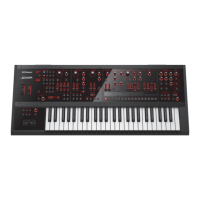65
Pattern Sequencer
4. Repeat step 3 to record each step.
MEMO
5 To erase the data at a step (or to enter a rest), press the [Erase]
button.
5 To enter a tie, press the [Enter] button.
5 To change the step that you’re recording, press one of the [01]–
[16] buttons.
5 If you want to use the [01]–[16] buttons to change the measures
that you’re controlling, refer to “Changing the Measures
Controlled by the Step Buttons” (p. 65).
5. Press the [Step Rec] button to stop recording.
Step Recording 2 (Step REC 2)
While playing or stopped, use the [01]–[16] buttons to record on the
selected step (step recording 2).
1. Press the [Step REC] button twice to turn Step REC o.
2. Use the ANALOG PART or DIGITAL PART On [01]–[04]
buttons to select the part that you want to record.
3. On the keyboard, play the note that you want to record,
and then use the [01]–[16] buttons to turn the step on.
The note length is the length you specify for the Step REC parameter
Type (note type).
MEMO
5 You can also record on a specied step by playing a note and
pressing a [01]–[16] button to specify the step. You can also
specify chords.
5 By turning a knob while holding down one of the [01]–[16]
buttons, you can record the last state of that knob in the specied
step.
5 Operation of the knob is recorded on the part selected in the
PART Select.
5 If you want to use the [01]–[16] buttons to change the measures
that you’re controlling, refer to “Changing the Measures
Controlled by the Step Buttons” (p. 65).
Playing Patterns
1. Press the [Play] button.
You can perform the following operations during playback.
Part Mute
Press [Shift] + each part’s On [01]–[04] buttons
Realtime Erase
& “Erasing Only a Portion of a Phrase (Realtime Erase)”
(p. 64)
2. To stop, press the [Play] button once again.
Changing the Measures Controlled by the
Step Buttons
If the pattern is longer than 16 steps, hold down the [Shift] button
and use the [1]–[4] buttons to change the range of measures and
beats that are controlled by the 16 step buttons.
Depending on the scale setting, you can also use the [Shift] button +
[01]–[08] buttons to change this.
Erasing an Entire Pattern (Pattern Erase)
Here’s how to erase an entire pattern.
1. Hold down the [Shift] button and press the [Erase] button.
The Erase screen appears.
2. Use the [-] [+] buttons to select what you want to erase.
Value
[-] [+]
Explanation
Track Erase only the data of the selected track.
SysEx Erase only the system exclusive data.
Tempo Erase only the tempo data.
All
Erase the entire contents of the pattern.
* Pattern Length, Scale, and Track Settings are not initialized. If
you want Pattern Length, Scale, and Track Settings to also be
initialized, execute Pattern Init. For more about Pattern Init,
refer to the owner’s manual section “Initializing a Sound
(Init)” (p. 7).
3. Press the [Enter] button.
The data is erased.
Pattern Utility
You can specify a pattern’s output destination settings, and import or
export SMF data.
1. Press the [Menu] button.
2. Select “PATTERN UTIL” and then press the [Enter] button.
3. Use the cursor [
K
] [
J
] buttons to select the function that
you want to execute, and then press the [Enter] button.
Function
Cursor [
K
] [
J
]
Explanation
Track Settings
Species the output destination of each track.
INT: The track plays the JD-XA's internal sound generator.
EXT: The track plays an external sound module connected to the
MIDI OUT/USB COMPUTER port.
BOTH The track plays the internal sound generator and the
external sound module.
OFF The track is not output.
* This setting is saved in the program together with the pattern.
SMF Import
Imports the specied SMF from the USB ash drive into the
temporary area.
* When you import, the current state of the temporary area is
discarded.
The SMF that you want to import must be saved in the “IMPORT”
folder of the USB ash drive.
SMF data that can be imported:
• Only SMF format 0 is supported.
• Up to four measures of SMF data can be imported. Subsequent
data is not imported.
MEMO
In the SMF Import screen, you can press the [Play] button to audition the
selected SMF.
SMF Export
Exports the pattern currently in the temporary area to the
“EXPORT_SMF” folder of the USB ash drive as an SMF with the
name you specify.

